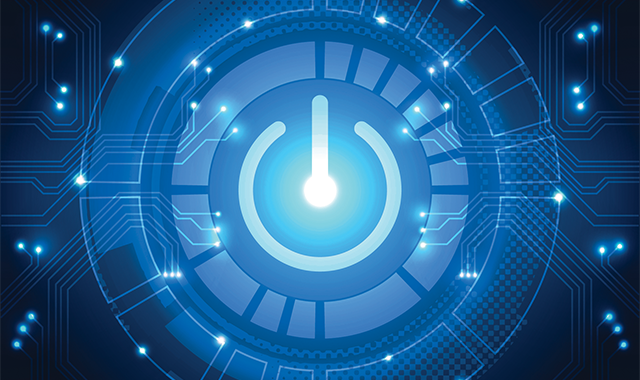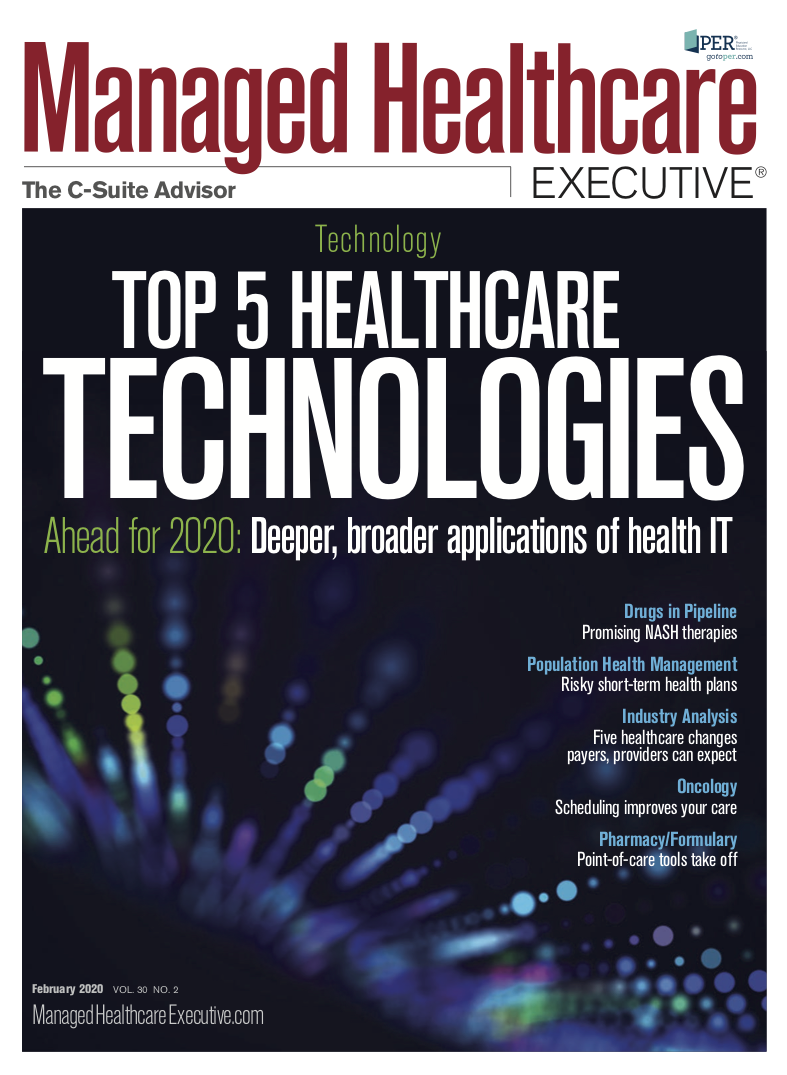Top 5 Healthcare Technologies
The top technologies for 2020 aren’t new, but they are on the cusp of moving into broader use in healthcare.

The top healthcare technologies for 2020 aren’t new, but they are on the cusp of moving into broader use.
In a sign of the growing maturity of some of these technologies-such as machine learning, voice recognition, and natural language processing-vendors are combining them to build solutions that solve real-world problems for providers and insurers.
That’s because the focus of digitally enabled healthcare “is less about the technologies to be used and more about doing things differently,” says John Bosco, chief technology officer at Northwell Health, a 23-hospital health system based in New Hyde Park, New York.
Here’s the list of technologies behind the transformation of business and clinical processes in 2020:
1. Voice Interfaces
Voice-to-text solutions are emerging to help physicians and other providers cut down on the amount of time they spend documenting patient care.
“The ability to use voice to automate documentation for clinicians and reduce the administrative burden and use of manual scribes is something that has been in research and development but is now being more widely deployed across the United States,” says Brian Kalis, managing director of digital health and innovation at Accenture, a consulting, technology and outsourcing firm based in based in Dublin, Ireland.
The players in the market include established voice-recognition vendors, large technology companies, and startups.
Related: 3 Technologies Providing Personalized Healthcare
For example, Suki combines voice recognition, natural language processing, and machine learning to create a documentation solution that runs on laptops, and Android and iOS devices. The Redwood City, California-based vendor claims that its software decreases the amount of time physicians spend on a clinical note by 76%, or from 13 minutes to three minutes.
Suki also claims that it’s integrated with the following electronic health records vendors: athenahealth, Watertown, Massachusetts; Cerner, Kansas City; eClinicalWorks, Westborough, Massachusetts; and Epic, Verona, Wisconsin, according to KLAS, a research and analysis company based in Orem, Utah, and focused on health information technology.
Suki rival Notable Health-based in San Mateo, California-has developed a workflow solution that combines patient intake and clinical documentation. Patients complete tasks such as registering and completing medical histories using their smartphones, while providers use digitally enabled watches to dictate visit summaries.
Chicago-based CommonSpirit Health, a 142-hospital Catholic health system, announced plans in 2019 to pilot Notable Health’s platform at some primary-care centers in California, with a goal of implementing the solution broadly across the organization.
Two other startup vendors of voice-to-text clinical documentation software are Robin Healthcare, Austin, Texas, and Saykara, Seattle, KLAS said in a 2019 blog post.
Legacy voice-recognition vendors also are developing intelligent voice-enabled documentation solutions. For example, Nuance Communications-based in Burlington, Massachusetts-and Microsoft-based in Redmond, Washington-are partnering to create a product to compete with the offerings from the startups. They hope to begin pilot testing their solution in 2020.
Meanwhile, Vanderbilt University Medical Center, an academic medical center based in Nashville, is combining voice recognition and natural language processing to create a solution that helps clinicians look up information in the electronic medical record.
Called Vanderbilt Enhanced Voice Assistant, the application “does what your phone does now. The idea is to ask a question of the health record,” explains Kevin Johnson, MD, Cornelius Vanderbilt professor and chair of the department of biomedical informatics and professor of pediatrics.
For example, providers could ask about their schedule of patients for the day or information about specific patients, such as their weight or medications. Johnson says providers could even ask a question such as, “Is there anything that I need to do today that I left in my notes from the last visit?”
“What we are trying to enable you to do is to have that conversation without having to stare at a computer screen,” he says.
The academic medical center, based in Nashville, Tennessee, plans to pilot the application in pediatric endocrinology in 2020 and then expand its use to other departments.
2. Natural Language Processing
Mountain View, California-based Google also is investing in solutions that ease providers’ workflow burden, in part, through the use of natural language processing.
In a blog post in November 2019, Google Health CEO David Feinberg, MD, said Ascension-a 150-hospital Catholic health system headquartered in St. Louis-is piloting a tool that uses Google’s finely honed search capabilities to help providers extract useful information from patients’ medical records. The idea is “to make health records more useful, more accessible and more searchable by pulling them into a single, easy-to-use interface for doctors,” Feinberg wrote.
Google is not alone. Accenture’s Kalis says that health systems and insurers also are using natural language processing to improve their interactions with consumers.
For example, he says, WellCare Health Plans, headquartered in Tampa, Florida, has been using a product from Sensentia that uses natural language processing to help call center employees search through insurance documentation using plain English to answer enrollees’ questions about health insurance benefits. Based in San Francisco, Sensentia uses the same technology for a product that allows enrollees to look up benefits information online by themselves.
On the health system side of the industry, one example is an online symptom checker at Milwaukee-based Froedert & the Medical College of Wisconsin health network, a five-hospital network and academic medical center, developed using natural language processing and machine learning. Called Buoy Health, the interactive tool asks questions to help guide consumers to the appropriate medical care.
3. Machine Learning
Machine learning will continue to be adopted in healthcare in 2020, focusing on “back office” types of applications, Johnson says. He describes these “as technologies that are designed to improve the overall throughput of healthcare either by predicting patients who have specific risks, like readmission risks or length of stay risks, or by potentially doing things like decreasing denial days or improving overall compliance with billing.”
Vanderbilt is currently testing two risk-prediction tools-one for sepsis and another for suicide-by running them in the background. What this means is that the tools assign risk scores to patients and then Vanderbilt’s staff compares the tool’s predictions to what actually happens to patients.
If the results are promising for either tool, the next step would be a randomized controlled trial involving a clinical intervention, Johnson says. Without an intervention that mitigates the risk effectively, a tool isn’t useful, he says. “There are multiple steps to do high-quality work in precision analytics.”
“At Vanderbilt we believe very strongly in the learning health system, which allows data to be used for knowledge generation, knowledge to be used to change action, and action to be used to be used to generate more data. That is the cycle,” Johnson says.
Gregg Pessin, analyst and senior director for healthcare delivery at Gartner, a research firm based in Stamford, Connecticut, agrees. He says machine learning won’t be widely deployed until the healthcare industry addresses two issues. First, the algorithms require access to large, verifiable sets of training data. Second, the AI engines need time to mature because their accuracy improves as they continue to learn by ingesting new data.
4. Internet of Things (IoT)
Digitally connected devices-known collectively as the internet of things, or IoT-is a promising source of the large-scale data sets needed to drive machine learning algorithms.
Many of these medical-grade digital devices-such as blood pressure cuffs and glucometers-are already recording patient data and transmitting the information to clinicians.
Pessin says the next step involves collecting and analyzing data from consumer devices such as digital watches and fitness trackers.
“In 2020, the Internet of Things itself will pass the tipping point for healthcare, and we will see that it becomes ubiquitous. There won't be a hospital, at least in the United States or the Western World, that isn't fully invested in IoT by the end of the year,” Pessin says.
In addition to incorporating data from consumer devices, Northwell Health’s Bosco says health systems are beginning to investigate how to move from intermittent data transmission from IoT devices to continuous patient monitoring.
Kalis says the movement toward continuous patient monitoring has been on the horizon for a number of years, but it is gaining some traction now because of the lower price points of the devices and sensors and the emergence of 5G on wireless networks.
Nonetheless, Bosco says there are three issues the industry needs to resolve before health systems adopt continuous patient monitoring at scale. He says that healthcare organizations need to implement the following:
- Technologies that can ingest and store vast amounts of real-time data.
- AI tools to analyze and interpret the information.
- Clinical interventions aimed at improving patient care based on the information generated by the AI algorithms.
Bosco says continuous patient monitoring “holds a lot of promise for driving down costs and improving the quality of the care that we are giving,” particularly in-home care. “In general, the home is the most convenient, most safe and least costly venue of care,“ Bosco says.
5. Robotic Process Automation
Robotic process automation-software that carries out high-volume, error-prone repetitive tasks-has been deployed in manufacturing, financial services and other industries. Now, some of those vendors are adapting their solutions for the healthcare arena.
One promising area involves automating repetitive tasks in the revenue cycle such as claims management, explains Doug Tolley, vice president of business development at KLAS.
Some examples: Automation Anywhere, is a vendor of robotic automation tools, located in San Jose, California; UiPath, New York, a vendor or robotic automation tools; and Blue Prism, a vendor of robotic automation tools, located in Warrington, United Kingdom.
Olive, headquartered in Columbus, Ohio, is slightly different because it was founded in 2012 specifically to develop solutions for the healthcare arena. KLAS, which interviewed five of
Olive’s customers for a recent report, says the vendor’s solution automates such tasks as verifying insurance eligibility checks, pre-authorization requests, and patient registration.
“I think it'll be far broader than just the rev cycle when it's really deployed into healthcare, but it started with some of the simpler areas of rev cycle,” Tolley says. “However, we haven't been able to yet, at KLAS, validate very many use cases outside of automating some of things in rev cycle,” he says. “We're looking for those test cases.”
With robotic process automation as well as the other top technologies for 2020, the real promise lies in their potential to help humans transform workflows, improving quality and reducing costs in healthcare. As Pessin explains, “We've been doing healthcare the same way for decades now, and we're on the precipice of a new way of delivering care. We're not in the new era, but we're just kind of walking through the doorway.”
Linda Wilson is an experienced writer and editor specializing in the healthcare industry.

In the Scope of Virtual Health and the Future of “Website” Manner, Per Ateev Mehrotra
August 10th 2023Briana Contreras, an editor of Managed Healthcare Executive, had the pleasure of catching up with MHE Editorial Advisory Board Member, Ateev Mehrotra, MD, MPH, who is a professor of healthcare policy at Harvard Medical School and an Associate Professor of Medicine and Hospitalist at Beth Israel Deaconess Medical Center.
Listen
Extending the Capabilities of the EHR Through Automation
August 2nd 2023Welcome back to another episode of "Tuning In to the C-Suite," where Briana Contreras, an editor of Managed Healthcare Executive, had the pleasure of chatting with Cindy Gaines, chief clinical transformation officer at Lumeon.
Listen